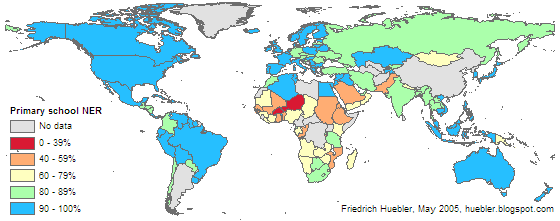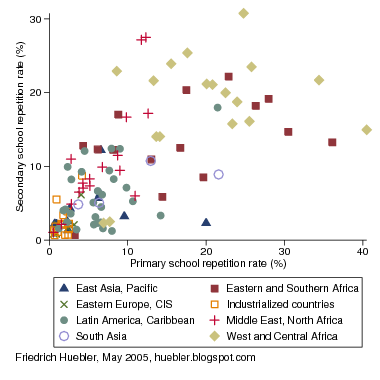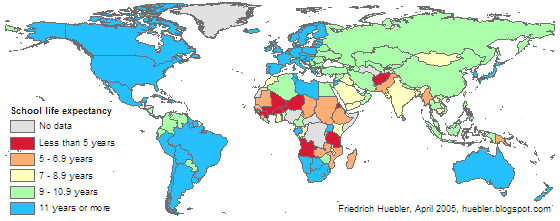At the end of April, the UNESCO Institute for Statistics released the Global Education Digest 2005 with the latest global education indicators, in most cases for the 2002/03 school year. The map below indicates the primary school net enrollment ratio (NER) in each country, that is the share of children of primary school age that are currently enrolled in primary school. For several countries, among them Argentina, China and the Democratic Republic of the Congo, no reliable statistics were available.
Primary school net enrollment ratio, 2002/2003

Data source: UNESCO Institute for Statistics (UIS). 2005. Global Education Digest 2005. Montreal: UIS.
Worldwide, 84% of all children of primary school age were enrolled in primary school. The highest NER values - above 90% - were reported for the industrialized countries, Latin America and the Caribbean, and East Asia and the Pacific. School enrollment is lowest in West and Central Africa (61%) and in Eastern and Southern Africa (69%). Many countries in these regions are far from the goal of universal primary education.
Primary school net enrollment ratio, 2002/03
| Region | Primary school NER (%) | ||
| Male | Female | Total | |
| East Asia, Pacific | 92.2 | 90.5 | 91.2 |
| Eastern and Southern Africa | 70.7 | 67.8 | 69.3 |
| Eastern Europe, CIS | 89.2 | 86.6 | 87.9 |
| Industrialized countries | 95.5 | 96.0 | 95.7 |
| Latin America, Caribbean | 95.1 | 93.6 | 95.0 |
| Middle East, North Africa | 83.9 | 77.7 | 80.9 |
| South Asia | 85.8 | 79.9 | 83.0 |
| West and Central Africa | 67.9 | 54.6 | 61.4 |
| World | 85.8 | 81.5 | 83.8 |
Note: Regional values are weighted by each country's population of primary school age.
In addition to having the lowest share of children in school, West and Central Africa is also the region with the highest gender disparity. Among boys, 68% were enrolled in primary school, compared to only 55% of girls.
Friedrich Huebler, 22 May 2005, Creative Commons License

